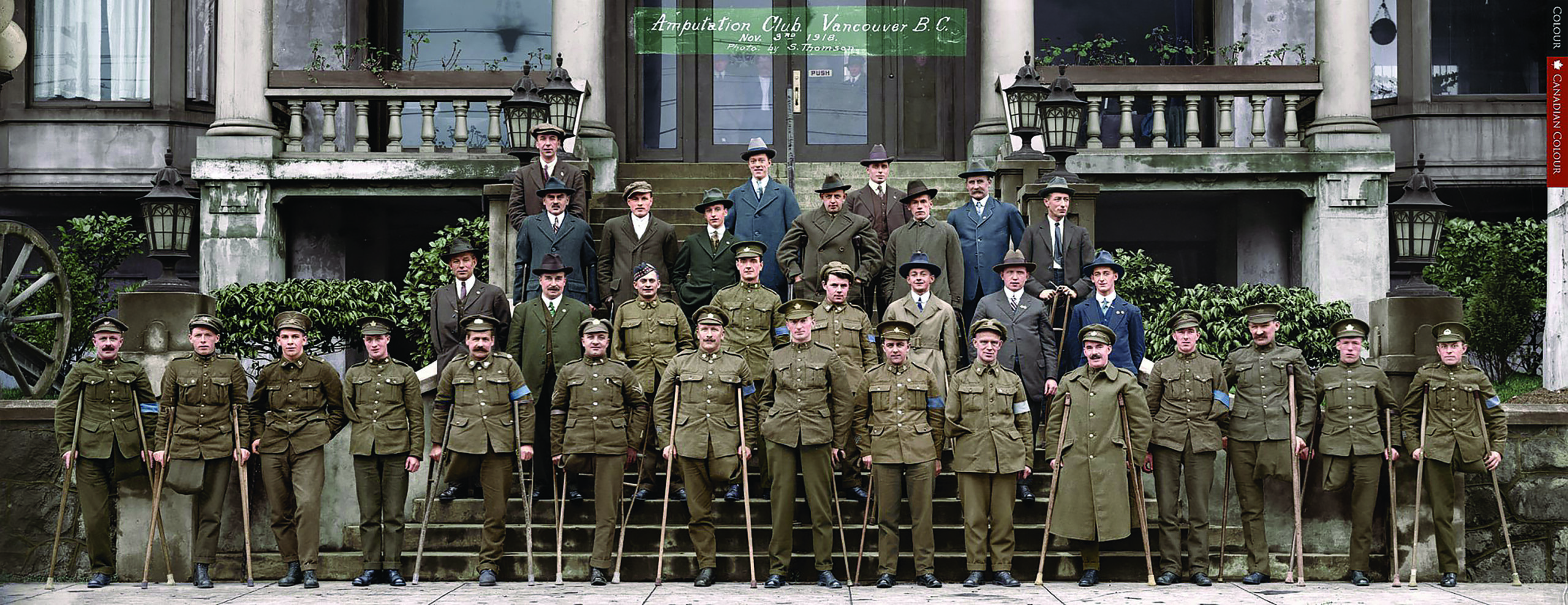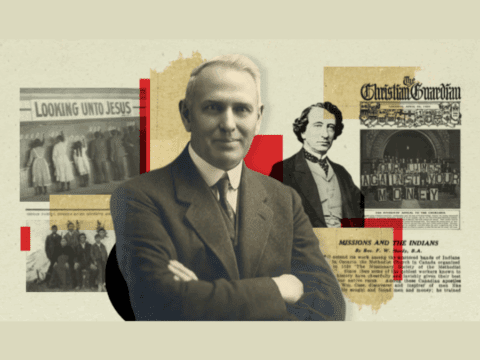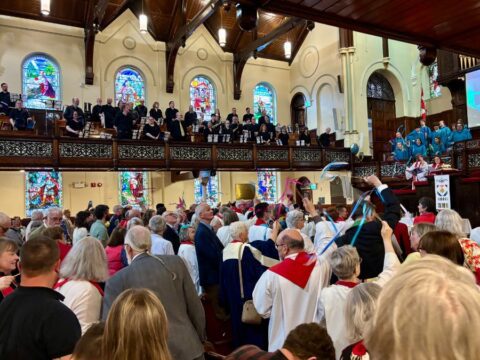It’s hard to imagine that the First World War could have an upside, but for Lt-Col. Sidney Lambert, a wartime injury served as a catalyst for generational change. After the fighting ended in 1918, the Calgary Regiment army padre and Methodist (later United Church) minister helped launch a peer support association for veterans with amputations — the flagship Canadian charity known today as War Amps.
A century after the organization’s birth, I’m at the War Amps headquarters, a squat building in southwest Ottawa, to meet Karen Valley. She is a lifelong United Church member and, when we meet, the head of commemorative and special projects for War Amps. (She recently left the position for an Office of Vocation job at The United Church of Canada.)
Valley leads me down a hallway where rows of vintage black and white photos of amputees line the walls. As we pass them, she singles out Padre Sidney Lambert. He’s easily recognizable by his thick frame, piercing dark eyes and stark-white clerical collar. Valley tells me the story of Lambert, War Amps and her own call to ministry.
Lambert lost his leg above the knee in a muddy battlefield at Ypres in northwest Belgium. He was recovering at College Street Military Hospital in Toronto when he dreamed up an association with a cornerstone philosophy of “amputees helping amputees,” says Valley.
He realized his vision, becoming the first president of the Amputations Association of the Great War in 1920.
(The name was changed to the War Amputations of Canada — War Amps for short — in 1939.) When the Second World War struck, Lambert arranged supportive meetings between First World War amputees and injured soldiers coming home on hospital ships. He also helped establish the War Amps’ key tag service, which continues to employ amputees and people with disabilities today.
Lambert appeared before the Senate multiple times, laying the groundwork for critical veterans’ legislation in Canada. He served as president of the War Amps for over 50 years until his death on May 5, 1971.
“It’s a history we don’t know as well as we should,” Valley says, her soft voice hardening with conviction. “While war is a terrible, tragic, horrible thing to happen, there’s good that has come from it. I believe it’s important to be able to look for the good that comes from the bad.”

Twenty-five years ago, Valley was on track to become a United Church minister when she took a break from her university studies to fill a short maternity leave contract at War Amps. She didn’t return to school. Instead, the organization became her ministry.
Valley, who wears a prosthetic left arm, remembers a seminar she was working at that brought families of amputees together to exchange tips on everything from making a ponytail with one hand to navigating insurance issues. There, a new mom whose baby girl was born with a congenital amputation like Valley’s took note of her wedding rings.
The mom told Valley, “I’m so glad to see you wear your wedding rings on your right hand. I always wondered what [my daughter] would do.” The little girl was missing her left hand.
“You have expectations when you become a parent,” Valley says, her voice trailing off. “It’s in those little moments that we are able to reassure families that it is going to be all right.”
In the pristine War Amps boardroom, the conversation swings from history to mechanics. Valley rolls up her sleeve to show me how her prosthetic arm works. She wears a sock under the arm to ensure a good fit, reduce friction and absorb sweat. Then, there’s a suspension sleeve that helps hold it on and a silicone glove that protects the mechanics from the elements. She says her prosthesis is temporary because the side effects of recent cancer treatment changed her limb shape. A newer, more permanent one is in the works.
Prosthetic limbs aren’t what the movies make them out to be. While stem cell research might prove to be a game changer for amputees, science is nowhere near delivering Luke Skywalker’s super-arm. In reality, most prosthetic hands only open and close, and artificial limbs can be touchy. Temperature, weight fluctuation, illness and even hormonal and fluid levels that shift throughout the day can affect one’s ability to wear them. Plus, each prosthesis has to be custom-made because every person’s residual limb is different.
Her voice sounds almost reverent when she says that Lambert’s motto, “It’s what’s left that counts,” continues to guide the organization 100 years later.
All this customization adds up. Valley’s current arm cost $15,000, but prosthetics can range from a few thousand dollars to $100,000, depending on the type and number of components required. And they’re not entirely covered by health insurance.
“Medical devices such as external prosthetics for limb amputees, wheel-chairs, or orthotics are outside the scope of the [services covered by the] Canada Health Act,” writes Sindy Souffront, a Health Canada media relations adviser, in an email. “However . . . most provinces provide some degree of coverage for these devices, with a number of jurisdictions providing full coverage.”
War Amps advocate Alexis McConachie says the term “full coverage” is misleading: “The amputation is done in hospital but then patients [have] to figure out the funding they need [for the prosthesis]. Canadians would be shocked to learn that they don’t have the appropriate coverage if they lose a limb.”
McConachie explains that only mid- to low-end artificial limbs qualify for full coverage, that the fee schedules are often outdated and that coverage doesn’t necessarily include the accessories needed to wear, maintain and repair artificial limbs. Then she fires off a host of other concerns: “The average lifespan of a prosthesis is between one and three years, but we see insurance policies that only cover one limb for life. We see people wearing the same limb that has been ill-fitting for 10-plus years because they can’t afford care. Some insurance companies require amputees to pay upfront costs and wait for reimbursement. It’s completely cost prohibitive to do that.”
She says that without a properly fitting artificial limb, amputees risk becoming housebound and depressed or susceptible to falls, vascular problems, scoliosis and other back issues. McConachie argues that government agencies and private insurers will pay more health-care costs in the long run if the upfront prosthetic care isn’t adequate.
The Canadian Medical Association, Health Canada and Statistics Canada don’t track the number of amputees living in Canada. War Amps estimates that around 50,000 Canadians have lost a limb, nearly 80 percent due to vascular disease caused by diabetes, the majority seniors. Without knowing exactly how many Canadians are affected, it’s hard to accurately pinpoint the overall cost of coverage.
War Amps communications director Leah Cameron slides a colourful Canada Post collector’s envelope across the boardroom table, decorated with images from the organization’s past and present. Among the photos is a smiling Lambert. A stamp above his head reads “100 years.”

Talk of anniversary celebrations winds around to perceptions of disability. Cameron, who was born with only one leg, smiles and shakes her head as she describes a run-of-the-mill grocery shopping excursion. A stranger sidled up to her and told her she is inspiring. “I was just grocery shopping. I’m like, ‘Okay. That’s great.’” She recognized the stranger was trying to be encouraging, “but underlying the comment is the assumption that there is a lower expectation for you in society.”
Not knowing what to expect was an early hurdle for parents Annette and Tom McLeod, who attend United churches in Embro and Kintore, Ont. They talk to me over speakerphone on a family road trip, explaining that during a routine ultrasound, they learned their son Noah would be born without part of his arm. War Amps connected them with a nearby family whose daughter has a similar disability.
That connection helped them navigate the first couple of years, learning what they might experience and how to find resources. “I can only describe the meeting as a relief,” says Annette.
The McLeods have since raised Noah to be independent. “We try really hard never to let the amputation be the reason not to try something or do something. We say, ‘The world isn’t going to change for you, and you still have chores to do . . . like cutting the lawn,’” says Annette with a laugh.
Drying the dishes. Tying shoes. Swinging a golf club. Noah, now 15, is emphatic that he can do anything two-handed people do. He just does it differently. “I’m not limited by the amputation,” he says. “When I’m on a new [hockey] team, there’s a reaction and questions. But usually that’s over pretty quickly as people get to know me. Lots of times people feel that they are being rude or shy about asking about my arm. I’m always happy to talk about it.”
Karen Valley guides me to the back door of the War Amps building, explaining that the organization sends speakers to churches and other venues to discuss safety, disability and issues related to amputees. Her voice sounds almost reverent when she says that Lambert’s motto, “It’s what’s left that counts,” continues to guide the organization 100 years later.
The visionary chaplain seems to have applied this philosophy to life in general. Just three weeks before his death, he wrote to the War Amps membership in the organization’s magazine The Fragment: “My old friend Canon Scott told me one time that we ‘old Sweats’ were living on borrowed time when we survived the War — and that God had loaned us this time to do His work. I shall be everlastingly grateful for the opportunity He gave me.”
This story originally appeared in The Observer’s November 2018 edition with the title “100 years of service.”














